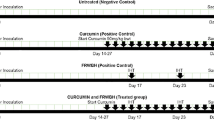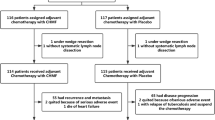Abstract
Objective
To investigate the anticancer effects of warming and relieving cold phlegm formula (温化寒痰复方, WRCP), a Chinese medical mixture composed of the aqueous extracts of Aconitum carmichaeli, Rhizoma bolbostemmatis, Phytolacca acinosa, Panax notoginseng, and Gekko swinhonis Gūenther, combined with 5-fluorouracil (5-FU) on human breast cancer in vivo.
Methods
Seventy-two Nu/Nu mice inoculated with MDA-MB-231 breast cancer cells were randomized into the control group, 5-FU group, high-dose WRCP (hWRCP) group, medium-dose WRCP (mWRCP) group, low-dose WRCP (lWRCP) group, or combination of mWRCP and 5-FU group in a 1:1:1:1:1:1 ratio. Drug administration was commenced on the day following tumor implantation. The control group was injected daily with normal saline (N.S.) intraperitoneally; the 5-FU group was injected with 5-FU at 30 mg/kg intraperitoneally every third day for a total of 7 treatments; the hWRCP group, mWRCP group and lWRCP group received daily doses of 5, 1, and 0.2 g/kg of WRCP, respectively, by gastric perfusion; and the combination group was treated with 5-FU plus mWRCP on the same schedules as above. All treatments lasted for 22 days. Tumor volume, tumor weight, inhibition rate of tumor weight, necrosis rate of tumor, organ index, and change in body weight of nude mice were measured.
Results
The combination group and the hWRCP group had significantly smaller tumor volumes (580±339 mm3 and 587±249 mm3 versus 1055±234 mm3, respectively), lower tumor weights (0.42±0.29 g and 0.52±0.29 g versus 0.80±0.15 g, respectively), and higher tumor necrosis rates (22.7% and 25.6% versus 9.4%, respectively) as compared with the control group (all <0.05). Similar changes were found in the 5-FU, mWRCP, and lWRCP groups when compared with the control group but were not statistically significant, except for the tumor weight for the 5-FU group. The combination group and the hWRCP group had significantly smaller tumor volumes compared with the 5-FU group (778±202 mm3, both <0.05). The combination group had the highest tumor inhibition rate (47.7%), followed by the hWRCP group (35.2%) and 5-FU group (28.3%). The 5-FU group had a lower body weight increase (1.37±2.06 g versus 5.60±0.72 g, <0.05) and a lower spleen index (4.064±1.774 mg/10 g versus 5.294±1.796 mg/10 g) as compared with the control group, whereas the combination group reversed the changes in the 5-FU group with the body weight increase of 3.52±1.80 g (P <0.05) and spleen index of 7.036±1.599 mg/10 g (P <0.05). The spleen indices in the hWRCP, mWRCP, and IWRCP group were all significantly higher than that in the 5-FU group (P <0.01 or P<0.05). No significant differences in body weight change were observed in WRCP groups compared with the control group P>0.05).
Conclusion
The treatment combination of WRCP and 5-FU was more effective in the inhibition of tumor growth than either agent alone and may have potentially additional benefit in improving the general condition and immunity of the mice with human breast cancer cell implants.
Similar content being viewed by others
References
Zhang M, Liu X, Li J, He L, Tripathy D. Chinese medicinal herbs to treat the side-effects of chemotherapy in breast cancer patients. Cochrane Database Syst Rev 2007;D4921.
Dou YQ, Yang MH, Wei ZM, Xiao C, Yang XH. The study of early application with Dixiong Decoction for non-small cell lung cancer to decrease the incidence and severity of radiation pneumonitis: a prospective, randomized clinical trial. Chin J Integr Med 2010;16:411–416.
Wu Y, Hua L, Jin Y. Clinical study on endometrial ovarian cyst treated by integrated laparoscopy and Chinese herbal medicine. Chin J Integr Tradit Chin Med (Chin) 2000;20:183–186.
Sun Y, Xun K, Wang Y, Chen X. A systematic review of the anticancer properties of berberine, a natural product from Chinese herbs. Anticancer Drugs 2009;20:757–769.
Qi F, Li A, Inagaki Y, Kokudo N, Tamura S, Nakata M, et al. Antitumor activity of extracts and compounds from the skin of the toad Bufo bufo gargarizans Cantor. Int Immunopharmacol 2011;11:342–349.
Lu CY, Chen XY. Progress of research on apoptosis of breast cancer cells. J Chin Integr Med (Chin) 2003;1:226–229.
Chen ZF, Liang H. Progresses in TCM metal-based antitumour agents. Anticancer Agents Med Chem 2010;10:412–423.
Zhou LY, Shan ZZ, You JL. Clinical observation on treatment of colonic cancer with combined treatment of chemotherapy and Chinese herbal medicine. Chin J Integr Med 2009;15:107–111.
Wei X, Chen ZY, Yang XY, Wu TX. Medicinal herbs for esophageal cancer. Cochrane Database Syst Rev 2007;D4520.
Wu TX, Munro AJ, Liu GJ. Chinese medical herbs for chemotherapy side effects in colorectal cancer patients. Cochrane Database Syst Rev 2005;D4540.
Shu X, McCulloch M, Xiao H, Broffman M, Gao J. Chinese herbal medicine and chemotherapy in the treatment of hepatocellular carcinoma: a meta-analysis of randomized controlled trials. Integr Cancer Ther 2005;4:219–229.
Tannock I. Cell kinetics and chemotherapy: a critical review. Cancer Treat Rep 1978;62:1117–1133.
Yan ZC, Chen D, Wu XZ, Xie GR, Ba Y, Yan Z. Effects of aqueous extracts of Aconitum carmichaeli, Rhizoma bolbostemmatis, Phytolacca acinosa, Panax notoginseng and Gekko swinhonis Guenther on Bel-7402 cells. World J Gastroenterol 2007;13:2743–2746.
Longley DB, Harkin DP, Johnston PG. 5-fluorouracil: mechanisms of action and clinical strategies. Nat Rev Cancer 2003;3:330–338.
Zou K, Ju JH, Xie H. Pretreatment with insulin enhances anticancer functions of 5-fluorouracil in human esophageal and colonic cancer cells. Acta Pharmacol Sin 2007;28:721–730.
Ming ZJ, Hu Y, Qiu YH, Cao L, Zhang XG. Synergistic effects of beta-aescin and 5-fluorouracil in human hepatocellular carcinoma SMMC-7721 cells. Phytomedicine 2010;17:575–580.
Reagan-Shaw S, Nihal M, Ahmad N. Dose translation from animal to human studies revisited. Faseb J 2008;22:659–661.
Britten CD, Hilsenbeck SG, Eckhardt SG, Marty J, Mangold G, MacDonald JR, et al. Enhanced antitumor activity of 6-hydroxymethylacylfulvene in combination with irinotecan and 5-fluorouracil in the HT29 human colon tumor xenograft model. Cancer Res 1999;59:1049–1053.
Ishikawa Y, Kubota T, Otani Y, Watanabe M, Teramoto T, Kumai K, et al. Dihydropyrimidine dehydrogenase activity and messenger RNA level may be related to the antitumor effect of 5-fluorouracil on human tumor xenografts in nude mice. Clin Cancer Res 1999;5:883–889.
Morioka H, Weissbach L, Vogel T, Nielsen GP, Faircloth GT, Shao L, et al. Antiangiogenesis treatment combined with chemotherapy produces chondrosarcoma necrosis. Clin Cancer Res 2003;9:1211–1217.
Parker WB, Cheng YC. Metabolism and mechanism of action of 5-fluorouracil. Pharmacol Ther 1990;48:381–395.
Fata F, Ron IG, Kemeny N, O’Reilly E, Klimstra D, Kelsen DP. 5-fluorouracil-induced small bowel toxicity in patients with colorectal carcinoma. Cancer 1999;86:1129–1134.
Hoskins J, Scott BJ. Evidence for distinct DNA- and RNA-based mechanisms of 5-fluorouracil cytotoxicity in Saccharomyces cerevisiae. Yeast 2007;24:861–870.
Wu X, Chen D, Xie GR. Effects of Gekko sulfated polysaccharide on the proliferation and differentiation of hepatic cancer cell line. Cell Biol Int 2006;30:659–664.
Marks LS, DiPaola RS, Nelson P, Chen S, Heber D, Belldegrun AS, et al. PC-SPES: herbal formulation for prostate cancer. Urology 2002;60:369–375.
Zhang QH, Chen KJ. Progress in research on PC-SPES anti-cancer agents in prostatic carcinoma in USA. Chin J Integr Tradit Chin Med (Chin) 2001;21:295–299.
Author information
Authors and Affiliations
Corresponding author
Additional information
Supported by the National Natural Science Foundation of China (No. 30801495)
Rights and permissions
About this article
Cite this article
Wang, Xl., Ma, F. & Wu, Xz. Anticancer effects of 5-fluorouracil combined with warming and relieving cold phlegm formula on human breast cancer. Chin. J. Integr. Med. 18, 599–604 (2012). https://doi.org/10.1007/s11655-011-0878-9
Received:
Published:
Issue Date:
DOI: https://doi.org/10.1007/s11655-011-0878-9




